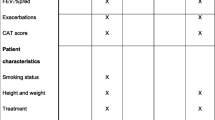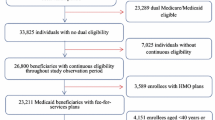Abstract
Purpose
Use of β-blockers (BBs) in patients with chronic obstructive pulmonary disease (COPD) and cardiovascular diseases is supported by increasing evidence. However, most of these studies focused on the survival outcome and used a non-active comparison, prevalent-user design. We aimed to examine the risk of overall death and cardiovascular outcomes associated with use of cardioselective BBs using an active comparison, incident cohort approach.
Methods
We identified COPD patients initiating cardioselective BBs or non-dihydropyridine calcium channel blockers (CCBs) between 2007 and 2011 in the population-based Taiwan database. A Cox regression model was applied to estimate hazard ratios (HRs) for overall death, cardiovascular death, and cardiovascular events comparing cardioselective BBs and non-dihydropyridine CCBs after propensity score matching. We also conducted sensitivity analyses to quantify the unmeasured confounding effect from COPD severity.
Results
A total of 107,902 patients were included. Cardioselective BBs were associated with a modest, lower risk of overall death (HR, 0.85; 95 % CI, 0.81–0.88). The reduced risk of overall death, however, was vulnerable to distribution of COPD severity and was easily weakened with lower prevalence of severe COPD patients in the initiators of cardioselective BBs and higher prevalence of severe COPD patients in the initiators of non-dihydropyridine CCBs. No excess benefit for cardiovascular death (HR, 1.05; 95 % CI, 0.97–1.13) or cardiovascular events (HR, 0.98; 95 % CI, 0.94–1.03) was detected.
Conclusion
The present study demonstrated a potential effect of confounding by COPD severity and therefore did not suggest an association between use of cardioselective BB and survival benefit in COPD patients.
Similar content being viewed by others
References
Global Initiative for Chronic Obstructive Lung Disease, Global strategy for the Diagnosis, management and prevention of chronic obstructive pulmonary diseases (2013) http://www.goldcopd.org/uploads/users/files/GOLD_Report_2013_Feb20.pdf. Accessed July 5, 2014
Sin DD, Man SFP (2005) Chronic obstructive pulmonary disease as a risk factor for cardiovascular morbidity and mortality. Proc Am Thorac Soc 2:8–11
Curkendall SM, DeLuise C, Jones JK, et al. (2006) Cardiovascular disease in patients with chronic obstructive pulmonary disease, Saskatchewan Canada cardiovascular disease in COPD patients. Ann Epidemiol 16:63–70
Huiart L, Ernst P, Suissa S (2005) Cardiovascular morbidity and mortality in COPD. Chest 128:2640–2646
Anthonisen NR, Connett JE, Kiley JP, et al. (1994) Effects of smoking intervention and the use of an inhaled anticholinergic bronchodilator on the rate of decline of FEV1. The Lung Health Study. JAMA 272:1497–1505
Smith SC Jr, Benjamin EJ, Bonow RO, et al. (2011) AHA/ACCF secondary prevention and risk reduction therapy for patients with coronary and other atherosclerotic vascular disease: 2011 update: a guideline from the American Heart Association and American College of Cardiology Foundation endorsed by the World Heart Federation and the Preventive Cardiovascular Nurses Association. J Am Coll Cardiol 58:2432–2446
Freemantle N, Cleland J, Young P, Mason J, Harrison J (1999) Beta blockade after myocardial infarction: systematic review and meta regression analysis. BMJ 318:1730–1737
Gottlieb SS, McCarter RJ, Vogel RA (1998) Effect of beta-blockade on mortality among high-risk and low-risk patients after myocardial infarction. N Engl J Med 339:489–497
Quint JK, Herrett E, Bhaskaran K, et al. (2013) Effect of β blockers on mortality after myocardial infarction in adults with COPD: population based cohort study of UK electronic healthcare records. BMJ 347:f6650
Chen J, Radford MJ, Wang Y, Marciniak TA, Krumholz HM (2001) Effectiveness of beta-blocker therapy after acute myocardial infarction in elderly patients with chronic obstructive pulmonary disease or asthma. J Am Coll Cardiol 37:1950–1956
Angeloni E, Melina G, Roscitano A, et al. (2013) β-Blockers improve survival of patients with chronic obstructive pulmonary disease after coronary artery bypass grafting. Ann Thorac Surg 95:525–531
van Gestel YR, Hoeks SE, Sin DD, et al. (2008) Impact of cardioselective beta-blockers on mortality in patients with chronic obstructive pulmonary disease and atherosclerosis. Am J Respir Crit Care Med 178:695–700
Short PM, Lipworth SI, Elder DH, Schembri S, Lipworth BJ (2011) Effect of beta blockers in treatment of chronic obstructive pulmonary disease: a retrospective cohort study. BMJ 342:d2549
Rutten FH, Zuithoff NP, Hak E, Grobbee DE, Hoes AW (2010) Beta-blockers may reduce mortality and risk of exacerbations in patients with chronic obstructive pulmonary disease. Arch Intern Med 170:880–887
DH A, Bryson CL, Fan VS, et al. (2004) Beta-blockers as single-agent therapy for hypertension and the risk of mortality among patients with chronic obstructive pulmonary disease. Am J Med 117:925–931
Lee DS, Markwardt S, McAvay GJ, et al. (2014) Effect of β-blockers on cardiac and pulmonary events and death in older adults with cardiovascular disease and chronic obstructive pulmonary disease. Med Care 52(Suppl 3):S45–S51
Ekström MP, Hermansson AB, Ström KE (2013) Effects of cardiovascular drugs on mortality in severe chronic obstructive pulmonary disease. Am J Respir Crit Care Med 187:715–720
Schneeweiss S (2006) Sensitivity analysis and external adjustment for unmeasured confounders in epidemiologic database studies of therapeutics. Pharmacoepidemiol Drug Saf 15:291–303
Ray WA, Daugherty JR, Griffin MR (2002) Lipid-lowering agents and the risk of hip fracture in a Medicaid population. Inj Prev 8:276–279
Johnson ES, Bartman BA, Briesacher BA, et al. (2013) The incident user design in comparative effectiveness research. Pharmacoepidemiol Drug Saf 22:1–6
Danaei G, Tavakkoli M, Hernán MA (2012) Bias in observational studies of prevalent users: lessons for comparative effectiveness research from a meta-analysis of statins. Am J Epidemiol 175:250–262
van der Woude HJ, Zaagsma J, Postma DS, Winter TH, van Hulst M, Aalbers R (2005) Detrimental effects of beta-blockers in COPD: a concern for nonselective beta-blockers. Chest 127:818–824
Olenchock BA, Fonarow GG, Pan W, et al. (2009) Current use of beta blockers in patients with reactive airway disease who are hospitalized with acute coronary syndromes. Am J Cardiol 103:295–300
Egred M, Shaw S, Mohammad B, Waitt P, Rodrigues E (2005) Under-use of beta-blockers in patients with ischaemic heart disease and concomitant chronic obstructive pulmonary disease. QJM 98:493–497
Andreas S, Anker SD, Scanlon PD, Somers VK (2005) Neurohumoral activation as a link to systemic manifestations of chronic lung disease. Chest 128:3618–3624
Fox K, Borer JS, Camm AJ, et al. (2007) Resting heart rate in cardiovascular disease. J Am Coll Cardiol 50:823–830
Lee TA, Schumock GT, Bartle B, Pickard AS (2009) Mortality risk in patients receiving drug regimens with theophylline for chronic obstructive pulmonary disease. Pharmacotherapy 29:1039–1053
Floyd JS, Blondon M, Moore KP, Boyko EJ, Smith NL (2016) Validation of methods for assessing cardiovascular disease using electronic health data in a cohort of veterans with diabetes. Pharmacoepidemiol Drug Saf 25:467–471
Birman-Deych E, Waterman AD, Yan Y, Nilasena DS, Radford MJ, Gage BF (2005) Accuracy of ICD-9-CM codes for identifying cardiovascular and stroke risk factors. Med Care 43:480–485
Mamadani M, Sykora K, Li P, et al. (2005) Readers’ guide to critical appraisal of cohort studies: 2. Assessing potential for confounding. BMJ 330:960–962
Lin DY, Psaty BM, Kronmal RA (1998) Assessing the sensitivity of regression results to unmeasured confounders in observational studies. Biometrics 54:948–963
Lange P, Marott JL, Vestbo J, Olsen KR, Ingebrigtsen TS, Dahl M, Nordestgaard BG (2012) Prediction of the clinical course of chronic obstructive pulmonary disease, using the new GOLD classification: a study of the general population. Am J Respir Crit Care Med 186:975–981
Lin R, Peng H, Nguyen LP, et al. (2008) Changes in beta 2-adrenoceptor and other signaling proteins produced by chronic administration of ‘beta-blockers’ in a murine asthma model. Pulm Pharmacol Ther 21:115–124
de Montmollin E, Aboab J, Mansart A, Annane D (2009) Bench-to-bedside review: beta-adrenergic modulation in sepsis. Crit Care 13:230
Bangalore S, Messerli FH, Cohen JD, et al. (2008) Verapamil-sustained release-based treatment strategy is equivalent to atenolol-based treatment strategy at reducing cardiovascular events in patients with prior myocardial infarction: an INternational VErapamil SR-Trandolapril (INVEST) substudy. Am Heart J 156:241–247
Shibata Y, Inoue S, Igarashi A, et al. (2013) A lower level of forced expiratory volume in 1 second is a risk factor for all-cause and cardiovascular mortality in a Japanese population: the Takahata study. PLoS One 8:e83725
Curkendall SM, Lanes S, de Luise C, Stang MR, Jones JK, She D, Goehring E Jr (2006) Chronic obstructive pulmonary disease severity and cardiovascular outcomes. Eur J Epidemiol 21:803–813
Author information
Authors and Affiliations
Corresponding author
Ethics declarations
The protocol was approved by the National Taiwan University Hospital Research Ethics Committee.
Funding
This study was in part supported by the Taiwan Department of Health grant (DOH101-TD-B-111-01), which did not play any role in the conception and design of study; collection, management, analysis, and interpretation of data; and preparation, review, or approval of the manuscript.
Conflict of interest
The authors declare that they have no competing interests.
Electronic supplementary material
ESM 1
(DOC 156 kb)
Rights and permissions
About this article
Cite this article
Dong, YH., Chang, CH., Wu, LC. et al. Use of cardioselective β-blockers and overall death and cardiovascular outcomes in patients with COPD: a population-based cohort study. Eur J Clin Pharmacol 72, 1265–1273 (2016). https://doi.org/10.1007/s00228-016-2097-y
Received:
Accepted:
Published:
Issue Date:
DOI: https://doi.org/10.1007/s00228-016-2097-y




